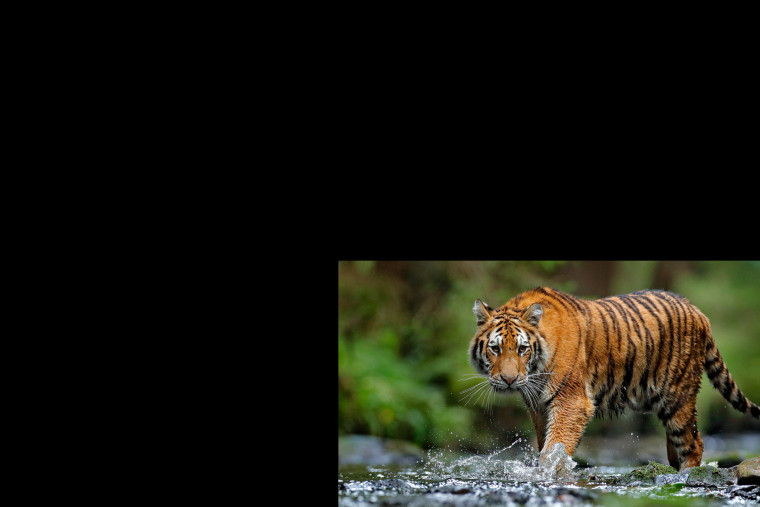America’s Big Cat Problem and How You Can Help
Open gallery

There are more tigers locked away in American basements, backyards, and bathrooms than there are left in the wild worldwide. In fact, regulation of these animals is so lax that we don’t even know how many captive tigers there are in the United States, with estimates ranging from 5,000 to 15,000. Fewer than 4,000 tigers remain in the wild.
These apex predators pose serious threats to public health and safety—about one American is killed every year by a captive big cat, while many more are injured.
Big cats also suffer tremendously in captivity, denied everything that is natural and important to them, confined to barren enclosures that are tens of thousands of times smaller than their natural ranges, and frequently denied basic care. While “big cats” encompass lions, jaguars, cheetahs and more, in the United States, the big cats most commonly kept in captivity are tigers.
Below, we provide an overview of America’s big cat problem, why it’s detrimental to the animals, and how you can be part of the solution rather than contributing to the problem.
Tiger Conservation and Tiger Farms
The tiger overpopulation crisis harms conservation efforts. Virtually all of these animals are tiger “mutts”—mixed subspecies, also referred to as generic or hybrid tigers, who the U.S. Fish and Wildlife Service (FWS) recognizes serve no conservation purpose whatsoever. Additionally, peer reviewed studies have found that seeing humans in close contact with imperiled wild animals can cause people to erroneously believe that these species are doing well and don’t need our help, thus undermining conservation efforts. As science and nature writer David Quamman put it, “they come carelessly to believe that the Bengal tiger … is alive and well because they have seen it.” Indeed, a study suggests that the prevalence of tigers, lions, and other imperiled species in our culture and media may create a misleading “virtual population” that actively biases our perception of the status of these animals in the wild, giving us an inflated perception of their vitality.
Internationally, tiger farms play a significant role in ongoing trafficking of tigers and trade in tiger parts and derivatives. The ongoing availability of tiger-based products from these farms undermines demand reduction efforts and threatens wild tigers, as suppliers work to meet demand and consumers demonstrate certain preferences for wild-sourced products. To be sure, the tiger farms in China, and the legal market for farmed tiger products in China, is the greatest threat, but our practices Stateside should stand as exemplar to the international community, especially on an issue on which the U.S. had led international and bilateral efforts. Seizures of tiger parts being imported and exported into the U.S. suggest that markets exist for tiger products in the U.S. as well. All steps to prohibit private tiger captivity is critical.
The USDA and the Photo-Op Problem
Where do the thousands of tigers in American backyards, basements, and bathrooms come from? You may be surprised to learn that their presence is directly tied to those cute baby animal photos you’ve seen on your social media feeds.
There’s no denying that cubs are adorable, and the temptation to have our photos taken with them is powerful. But most people don’t think about where these animals are coming from—or where they’re ending up.
Currently, under the Animal Welfare Act (AWA), the U.S. Department of Agriculture (USDA) allows exhibitors to profit off of public “photo-ops” with big cat cubs who are between four and twelve weeks old. Allowing public encounters during this thirteen-week time period—rather than prohibiting them altogether, which is well within the USDA’s authority—creates a demand for a constant supply of new cubs.
In the wild, tiger cubs stay with their protective and nurturing mothers for about two years, while female lion cubs stay with their mothers and the rest of their pride for life. But the cub petting industry forcibly removes these animals from their mothers—often when they are just days or even hours old—so that they can “acclimate” them to handling. This separation results in acute trauma and robs cubs of the opportunity to learn basic life skills. Meanwhile, their mothers are re-impregnated, treated as nothing but breeding machines for cub mills.
Before long, even though their immune systems aren’t yet fully developed, cubs are manhandled by the public, often for hours on end when they should be sleeping, causing stress and even terror. When they act out in response, they are often struck or otherwise punished.
Sometimes cubs are also declawed, to make them easier and less dangerous to handle. Declawing is painful and permanently crippling—the equivalent of amputating your fingers at the first joint. It causes acute wounds and the risk of chronic lameness, pain, and psychological distress, as claws are essential for species-specific behavior. A USDA inspection of one cub petting facility found two tiger cubs who were still bleeding, hesitant to walk, and vocalizing in apparent pain weeks after having been declawed. They died soon thereafter.
Those cubs who do survive quickly “age out”—become too old to be used for profitable photo-ops. Many of these animals end up in private hands.
All of this is not just allowed, but incentivized, by the USDA’s policy of allowing the public to handle cubs under the AWA. By allowing this cycle of abuse and constant breeding and disposal of cubs, the agency is complicit in America’s big cat overpopulation crisis.
Nearly a decade ago, a broad coalition that included the Humane Society of the United States, World Wildlife Fund, Global Federation of Animal Sanctuaries, Big Cat Rescue, Detroit Zoological Society, and more, petitioned the USDA to prohibit public contact with big cat cubs (as well as other primates and bears). Nearly a decade later, this petition is still languishing with the agency.
Thankfully, Congress is stepping up where the USDA has fallen down, with the Big Cat Public Safety Act (BCPSA).
Congress to the Rescue—The Big Cat Public Safety Act
For years, the BCPSA—legislation aimed at addressing America’s big cat overpopulation—has been introduced in Congress. In December of 2020, it was finally passed by the House, with strong bipartisan support. Unfortunately, the session ended before the Senate could vote on the issue.
If we all help, this can be the session that Congress finally passes this important bill!
Just days into the new Congressional session, Representatives Mike Quigley (D-Ill.) and Brian Fitzpatrick (R-Penn.) reintroduced the bill as H.R. 263.
The BCPSA would make it illegal for anyone to allow public contact with big cats—defined to include lions, tigers, leopards, cheetahs, jaguars, cougars, and any hybrid of such species—and it would ban private ownership of these animals. Zoos and bona fide sanctuaries would still be allowed to possess these animals, so long as they do not allow public contact. There is also a “grandfather” clause for those already in possession of big cats, but they too would be prohibited from allowing public contact; they would also be required to register with the FWS, and prohibited from breeding or otherwise acquiring more big cats. Violations would be subject to fines of up to $20,000 and/or imprisonment for up to five years.
What YOU Can Do
- Don’t support businesses that contribute to America’s big cat problem. Say no to cub petting and photo-ops with cubs. It is not only damaging to cubs, it is one of the single greatest sources of revenue for tiger breeders and exhibitors.
- Be a good citizen on social media. Avoid liking, sharing, or otherwise supporting images that promote cub petting and photo-ops. Better yet, when you see these images in your social media feed, politely educate others. Many people are unwittingly participating in these activities without realizing how they are harming animals.
- Share this blog to help raise awareness about America’s big cat overpopulation crisis, the problems with cub petting, and the importance of the BCPSA.
- Be a citizen advocate. Contact your federal representative and ask them to co-sponsor or otherwise support the BCPSA. Find your representative here. Make sure to note that you are a constituent and to reference the bill number (H.R. 263). Encourage others you know to contact their representative as well.
- Donate to the Center for Animal Law Studies to support our work to keep wild animals in the wild. Through our Global Law Alliance for Animals and the Environment, we are tackling key threats facing wild animals, such as: direct exploitation, habitat conservation, the wildlife trade, poaching, the extinction crisis, and more.
-
Want to learn more? You can watch a presentation on America’s Captive Tiger Crisis with Professor Winders and veterinarian Dr. Heather Rally here, and listen to Professor Winders discuss the legal issues behind Netflix’s Tiger King on the podcast Strict Scrutiny here.
We all have an important role to play in creating a better future for tigers and other big cats.

Delcianna (Delci) Winders is an assistant clinical professor of law at Lewis & Clark Law School, where she directs our Animal Law Litigation Clinic (ALLC)—the nation’s only clinic focused exclusively on animal law litigation and advancing protections for farmed animals. Professor Winders’ animal law and administrative law scholarship has appeared in the Denver Law Review, Florida State Law Review, Ohio State Law Journal, NYU Law Review, and Animal Law Review. She has also published extensively in the popular press, including The Hill, National Geographic, Newsweek, New York Daily News, Salon, and U.S.A. Today.


The Center for Animal Law Studies (CALS) was founded in 2008 with a mission to educate the next generation of animal law attorneys and advance animal protection through the law. With vision and bold risk-taking, CALS has since developed into a world-renowned animal law epicenter, with the most comprehensive animal law curriculum offered anywhere. CALS recently launched the Global Law Alliance for Animals and the Environment, as champions for wild animals and wild spaces. In addition, CALS is the only program that offers an advanced legal degree in animal law and three specialty Animal Law Clinics. CALS is a fully self-funded nonprofit organization operating under the Lewis & Clark College 501(c)(3) tax-exempt status, and is only able to provide these educational opportunities through donations and grants.
More Center for Animal Law Studies Stories
Center for Animal Law Studies is located in Wood Hall on the Law Campus.
MSC: 51
email cals@lclark.edu
voice 503-768-6960
Center for Animal Law Studies
Lewis & Clark Law School
10101 S. Terwilliger Boulevard MSC 51
Portland OR 97219

